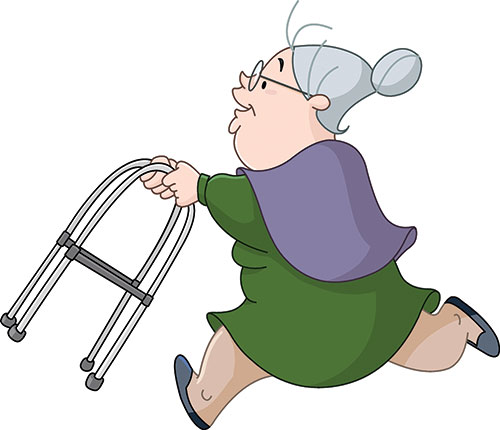By Caroline Chenoweth
Stubborn, difficult and just not interested—how do I persuade my Uncle Louis that he needs a walker?
In my case, it’s my Uncle Louis, but you might be having a similar discussion with your dad or grandma. Whoever it is, two commonalities will remain: that person means a lot to you and needs a walker. But, sadly, they’re not the least bit interested in this shiny new gift. For both of your sakes, you can’t be living like the song lyrics from The Police: “Every move you make, Every step you take, I’ll be watching you.” You can’t always be watching over your loved one, so what are you going to do to make sure they use their walker?
Ask questions
First, before we go blaming Uncle Louis for not “loving it,” the first thing to consider is whether his walker is just not a good fit. A walker, like a car or a really fine pair of shoes, is a personal investment.
Walkers can vary significantly in price and not all are created equal. So, before thinking about how to persuade Uncle Louis to use his walker, ask him some questions. What is it about the walker that he doesn’t like? Are the brakes too tough? Does the walker hurt his wrists? Does he have to lean too far down to reach the handles, or too far up? Are his back or shoulders aching? Is the walker too heavy to lift to put in the trunk of the car when he leaves the house? Is it hard to get upstairs? Can he manage to bring it downstairs or it is stuck on one level of the house? Is it too bulky to manoeuvre? Is it embarrassing to use? All of these factors can easily lead Uncle Louis to feel that he’s better off without any mechanical help.

Get a good fit
Your next move is to visit a specialized physiotherapy or occupational therapy clinic where they will fit the walker. Most clinics don’t require a physician referral to make an appointment, but check with your insurance provider as you might need a referral to cover the costs. In Ontario, when searching for the right clinic, confirm that the therapist is ADP (Assistive Devices Program) authorized. The Assistive Devices Program is run through the Ontario Ministry of Health and is extremely beneficial, as it will cover 75 per cent of the total cost of the walker. But it will only apply if the therapist and equipment vendor are authorized under the program and it doesn’t operate retroactively. Visit ontario.ca/page/assistive-devices-program for more information.
Persuasion
Now, after double- and triple-checking that Uncle Louis’ walker is the best fit, and yet he still won’t use it, it’s time to move to phase two: Persuasion. In my experience of working in a physical rehabilitation hospital, persuasion works best when it is tailored to each person’s personality. Perhaps Uncle Louis is they type of person who needs to be made aware of the risks of not using a walker.
Hint #1: Largely speaking, the more a person falls, the greater risk they are at of falling again.
Hint #2: Because of a multitude of factors, men lose significant bone density by the time they reach 65 years. Therefore, there is an increased likelihood that a minor fall will lead to a fractured hip and long-term hospitalization.
If uncle Louis says, “That won’t happen to me,” try sharing the story of a friend or neighbour who refused to use their walker and is now in much worse shape. If this isn’t working and Uncle Louis is laughing in the face of the risk, talk about the effects of his choices on those around him. Is he putting more physical strain and stress on his spouse or children?
Last but not least, if his rebuttal is: “Oh, you worry too much,” switch to a more positive approach. Find an activity that Uncle Louis used to enjoy but has stopped because of his health. Then, with you or another companion, take small steps to help him re-engage in that activity using the walker. He might have previously gotten out of breath walking to the end of the driveway—but, with the walker, he is now less out of breath and able to go further. Slowly, take bigger steps and help Uncle Louis to engage in more activities. Eventually, he will see how he can be independent again and rejoin the activity he used to love.
Hopefully, one or all of these approaches will have Uncle Louis loving his walker like he loved his first car.
Caroline Chenoweth, MScOT Reg (Ont) has practiced occupational therapy within long-term care homes, seniors-focused family health teams and acute-care hospitals.
Choosing a walker
Work with a health professional when selecting the best walker for your needs. Before purchasing, you’ll need to make sure that the model you selected can accommodate your height and weight. You will also need to think about where you’ll use and store your walker. Otherwise, you will be setting yourself up for discomfort or an accident.
Too low: A walker that’s not the right height will cause you to stoop and lead to back pain.
Too far ahead: Stand tall and push the walker only slightly ahead of you, and then step into it.
Too risky: Borrowing a walker from a friend can cause injury. Only use a walker that’s been adjusted for you.
Indoors or out: If you’ll be traveling about, you’ll need a walker that folds and has larger wheels. If you’re staying indoors for the most part, a standard walker might be easier.
Grips: Consider a softer grip if your hands tend to sweat. A larger grip may benefit you if you live with arthritis.













